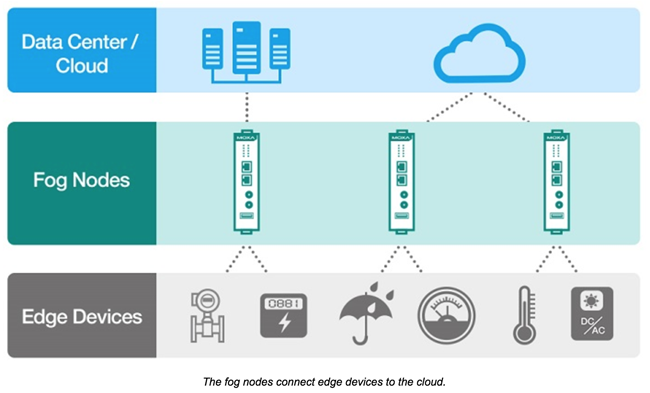Industry experts have warned that the cloud-computing models deployed in many IIoT systems today are ill equipped to deal with the volume of data generated by the billions of IoT devices that are slated to go online in the next couple of years. To add to this, these devices also generate data in a multitude of formats using a variety of protocols, making their acquisition and real-time processing difficult. In this article, we explain two alternatives to the cloud computing model—fog computing and edge computing, and discuss why companies are investing in solutions based on these models.
Cloud Computing vs. Fog Computing vs. Edge Computing
Cloud computing in the IoT is about centralized data processing. In contrast, fog computing and edge computing models focus on moving computational power, storage capacity, device-control capability, and networking power closer to the devices. The key to a successful IIoT project is choosing a computational model that is the best fit for your organization’s needs.
Fog computing is a term created by Cisco that is used to describe computing on devices in an intermediate layer called the fog layer between the cloud and the IoT edge devices. The fog layer consists of fog nodes, which are essentially industrial controllers, gateway computers, switches, and I/O devices that provide computing, storage, and connectivity services. The fog computing model extends the cloud closer to the edge of your network where the devices reside, and facilitates edge intelligence.
Edge computing is similar to fog computing and the two terms are often used interchangeably. Edge computing solutions build intelligence into edge devices to enable processing and analysis of data locally.

Here are some critical elements to consider when choosing a computational model for your IIoT.
Latency
Sending all of your device data to the cloud for processing and analytics can take anywhere between a quick few minutes to several days at a stretch. For example, if your IIoT devices are generating one terabyte (TB) of data per day, it could take you a couple of days to transfer this data to the cloud, process it, and generate actionable items from the data. By this time, the window of opportunity to act on the conclusions drawn from the data may have passed. Today’s business applications demand a response time in the order of seconds or milliseconds. Time-sensitive applications, such as Industrial IoT, need immediate processing of device data to be able to take timely corrective actions. The fog computing model can minimize latency and enable quick decision making when compared to the cloud computing model.
Data-transfer and bandwidth cost
Transferring large volumes of data from the edge of the network to a cloud server can be prohibitively expensive. For example a typical offshore oil platform can generate 1 to 2 TB of data per day. The most common way for offshore oil platforms to transfer data is via a satellite connection, where data speeds range from 64 Kbps to 2 Mbps. With these data speeds, it would take more than 12 days to transfer one day’s worth of data from the oil platform to a central repository. Furthermore, the cost of transferring this data on a daily basis could lead to unsustainable communication costs in the long run.
Security
Sending sensitive operational data from the edge to the cloud puts the data and your edge devices at risk. Multiple levels of security need to be put in place in an IIoT system to ensure that the data is securely transferred to cloud storage systems. Processing data at the edge helps prevent data breaches and enables faster responses.
Independent operation in remote locations
Fog computing and edge computing models enable remote locations to reduce downtime and operate independently when the central system is inaccessible. For example, if there is a network outage and connectivity to the cloud system is lost, field sites can use local computing power to process and analyze data. Processed data can then be sent to the cloud for long-term storage when the connection is restored.
Moxa Can Help You Ride the New IIoT Wave
Moxa’s IIoT Gateway solution can help you fast-track your IIoT projects. It includes a UC-8112-LX Edge Computer, ThingsPro Gateway software, and ThingsPro Server software to help you ramp up your IIoT projects for cloud-based applications as well as build local intelligence at the edge. Moxa’s IIoT solution can provide:
- Easy integration of IT and OT systems
- Modbus and MQTT protocol support
- 4G communication support
- Built-in client interfaces to cloud services such as AWS
- Secure connections through VPN
- C and Python APIs to process data locally
- UC-8112 computer for local intelligence and local control
- Future-proof design for easy system expansion
Moxa’s IIoT Gateway Starter Kit can help you jump-start your IIoT development. To learn more, download the white paper.